|
BassZillaRiZation: or why I eventually decided to build BassZilla
by Doc J. Noble
Lets talk about bass. Tones in the upper bass to lower mid range are what musicians refer to as the ‘fundamentals’. These registers provide the sense of body and resonance that make sound believable. The fundamentals really do need to be ‘correct’ if we are hoping to achieve natural sound – and this is no easy matter to solve. My own patient experiments with loudspeaker DIY – more on this topic a bit later – helped me to appreciate the importance of this fact. For the sceptics among us, let’s count octaves. Assuming that 1K is at the centre of human hearing, four octaves down brings us to 62.5Hz – halving as we go, 500, 250, 125, 62.5Hz – and four octaves up takes us to 16K – doubling as we go, 2, 4, 8, 16K. Hence one octave down from the centre of human hearing brings 500Hz which is definitely ‘in the bass’. One might be tempted to say that half our hearing is in the bass, which clearly is a misrepresentation, but one that is well meaning, because I think it’s safe to say that far too many audiophiles are obsessed with frequency extension. One may even be forgiven for thinking that ‘high end = high frequency rendition’ from the way some of these folks carry on. Detail, air, space and ambient information are all first class in my book, sign me up and beam me down Scottie! But these important aspects sound lame and artificial unless laid upon a clean and firm presentation of the fundaments below – i.e. bass–lower mid tones. Ask any musician with soul. The touchstone of musical expression lies in the artful manipulation of tone. The tension and near infinite subtlety of tonal contrast is an artefact that comes directly on the nervous system. It moves emotion. We listen with our bodies as much with our ears and minds. Overly cerebral, disembodied audio need not apply. Experiments with loudspeaker design taught me to appreciate the important fact that tone depth – which is akin to colour depth in photography – is largely in the bass, presence is largely in the midrange, whilst air/texture/harmonic character are mostly in the treble region. And of course, we hear each on top of the other, such that any overly rigid attempt to separate these things is likely to fail – this being the obvious counterpoint to these, nevertheless, helpful observations.
I do not wish to be misunderstood. I am not saying that bass is more important than everything else. From a musical point of view it’s obvious that all frequencies are of equal importance. The totality is what matters most. What I am saying is that when it comes to loudspeaker design, the question of bass and of the fundamental registers is paramount. The logic of this assertion will hopefully be clear as we proceed. I think a loudspeaker system should be built upon a firm foundation. Bass provides that foundation in at least two ways. Since the bass transducer is by far the biggest aspect of a loudspeaker it invariably forms the physical foundation from which the design unfolds. Decisions made here affect everything else, as there are clear practical limits when it comes to combining certain kinds of transducers in certain configurations. It is not for no reason that we commonly designate loudspeaker types according to their bass loading strategy, hence sealed box versus bass reflex versus transmission line, and so forth. But more importantly the bass also provides an anchor to the sound – as elaborated above – and in addition, it just so happens that this anchor coincides with the ‘power-band’ in terms of energy transfer. When reproducing recorded music, it is the bass to lower mid region that by far consumes the most power. This is where an amplifier struggles most to maintain control, and unfortunately, is also the band most responsible for the musical perceptions of power, drive and dynamic force. Oops I forgot to mention that the proviso to this discussion is high efficiency – high efficiency so that we can drive, unencumbered, with low power SET style amplifiers – if your penchant is for current sapping loudspeaker designs, please Google on to another site. Mother nature is not terribly kind to the cause of the SET revolution. Low power requires efficiency, and efficiency requires large size. A bass horn is obviously the best way to get the most efficient solution, but bass horns have to be utterly huge to reproduce adequate lows. Bass horns, in most cases, are simply not house-compliant, and the ones that are commonly offered – no surprise – seriously lack in terms of sub 50Hz bass. Dipole woofers are truly wonderful, but due to cancellation of the back wave – unless, again, utterly huge – most dipole bass systems are implemented with the help of bass augmentation, which is another way of saying that a bass dipole is, for all intents and purposes, an inefficient design. When you survey the landscape and do the math, the most compact, and most reasonable solution is a fairly big bass reflex cab, sporting a tasty 15” cone. The infamous Onken style 15” reflex cabinets of yore spring to mind. When executed right a big 15” bass reflex cab is hard to beat. This approach can easily get you into 97dB territory, and this with modern pro audio drivers – many of which are of exceptional quality – as is the case with BassZilla. As much as 100dB is ‘possible’ from a bass reflex system, but this figure requires the use of more exotic ‘vintage’ drivers, or at least drivers of older lineage, where light weight cones are used and here tuned for higher fundamental resonance than is common these says. But, invariably, eking out more efficiency from a 15 will mean a loss of lower bass response, so it remains an open-ended question as to which is the better approach at the end of the day. I used to think the vintage, light bass cone approach was the right way, and in fact I happen to own a lovely pair of Goodmans Audiom 61, 12” woofers, which are a fine example of vintage wide-band design, and these woofs are very good indeed (see Figure 1).
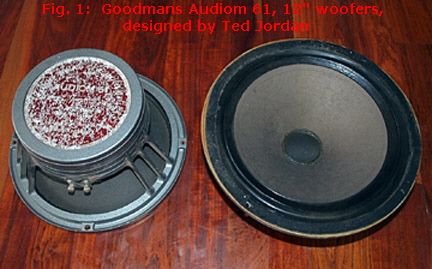 |
Yet, having lived with BassZilla, I can safely say that Dick has selected one mighty fine woofer, one with punch and superb pitch definition down low. The Eminence Definimax 4015LF has a heavy cone, which initially seems counter intuitive, but in fact makes perfect sense, as heavy paper cones are less likely to buckle under low frequency resonance, and this type is known for its good deep bass character. Furthermore, we must consider the effect of reflected energy in a boxed system. A heavy cone, with powerful magnet assembly, is far less likely to be knocked about by reflected energy. When the heavy Definimax pushes air inside that cab, it’s fairly clear who is the boss. So a 97dB bass system, as compromise, is not so bad after all.
With this bass system in place, the next question is what to do on top. And perhaps you can see where I am going with this line of thought, because we know it’s good practice to blend like with like, and since we have accepted a 97dB, direct radiating compromise in the lows, this must surely mean that a direct radiating 97dB or similar mid driver and tweet are on the agenda. Horns are great, well at least, the really good ones I heard were truly GREAT. A front horn can launch a massive wave front, indeed the size of the mouth, and from this a thrilling sense of specialization. Forget about the overly pretty sound of small and refined 2-way designs, a horn moves air and that’s a mighty fine thing. A front horn can get you as high as 108dB for one watt, which is pretty darn high, and I for one would love to scale these heights, but the tough question is in what way is this a usable figure, because we have to marry to the bass system below. The extra efficiency of a front horn is difficult to take advantage off, as sadly, we are constrained by what’s possible below. Once again we are back to that power-band issue, which has knock on effect into the question of efficiency and system design, and in fact is highlighted in the context of efficient designs. Bi-amping, of course, is a good way to solve this issue, allowing for usable, extra efficiency on top. But clearly it’s best to marry with like, and care should be taken with this approach, as a low efficiency woof driven with lots of power is unlikely to marry to a high efficiency horn driven by flea power. Of course there are degrees, and I am not arguing a definitive no. I would say the Avantgarde Duo demonstrates my point, however. That front mid horn sounds glorious, but bass is a big let down, and I could never bring myself to want to own a pair of these, as mid to bass discombobularity is not my thing. The Avantgarde Duo presents its logic as being a design that was conceived from the midrange down, whereas what I am arguing for, in the context of efficient designs, is an approach that builds from the bottom up. A further difficulty with front horns, is the high cut off point, commonly in the 500 to 800Hz region, which often requires a boxed woofer to play up fairly high into the lower mid register. 100-800Hz is a very critical region in terms of dynamic response, in terms of impact/slam and in terms of tone, and it seems a shame to make a boxed woofer responsible for these frequencies, hence the question emerges, does a boxed woofer mitigate against the good of a front horn/compression driver above?
I wish to emphasize that in making these points, I am NOT wishing to diss other approaches. I am 100% in full support of variety, there are many ways to skin the cat. I am not saying that BassZilla is the only, or even the best approach. Other approaches will no doubt bring their own unique qualities to the table. What I am trying to do here is to explain what I perceive to be the good logic of Dick’s approach, in the context of a high efficiency SET friendly design. So, no need to get hot under the collar and sell your lovely horns – not if their working for you, that is.
At this point you may have noticed my repeated reference to horns. This happens to be the case, because before coming to BassZilla I had to decide, and the choice was down to a multi-way horn versus a BassZilla style, open baffle approach. The considerations that are provided above helped me to swing in favour of BassZilla. But in actual fact the final decision was simpler than this. I had to decide what type of sound I wanted to achieve. The forte of horns is dynamics, immediacy and presence. Horn loaded drivers are mono-poles – i.e. radiating forward – with narrowed dispersion, which goes a long way to explaining the fun. An open baffle is a dipole – i.e. radiating both forwards and backwards – and the big deal here is spaciousness and especially depth perspective. Horns have great dynamics but don’t do depth, well not like a dipole they don’t. So, in the end, I had to decide what type of presentation I wanted. This is not a question of right or wrong, but of the good, the better and of listening taste. After some soul searching I willingly threw my lot with the dipole camp, as I really do love the involving spaciousness, the naturalness and hall like depth perspective that the best dipoles are famous for.
Returning to the main argument regarding our 15” reflex loaded bass system. A direct radiating mid and tweet are, clearly, firmly on the table, and the cool bit is that this choice allows for a lowish 150 to 250Hz crossover point to the bass, and since it’s a given that the mid driver is mounted on OB – yea, this being the further proviso, namely the lovely depth perspective and transparency of a dipole, cos we all love Estats, right – we can now reproduce the more critical and ‘intelligible’ upper bass registers on a fast, responsive, finely detailed and very open sounding paper cone dipole mid driver, one that can be made to marry seamlessly to a fast 15” paper cone below. I think the 250-1K region reproduced by a fast 8” high efficiency wide-band dipole is part of the unique genius of Dick Olsher’s original plan!
Once again, please note this is not to say that other approaches don’t work. Not to say that multi-way horns are flawed – the truth is all loudspeakers are flawed! Not to say no to the other good ways of doing loudspeaker design. But rather, to clarify what is good, and what is logical, what is right, indeed what ‘sounds right’ from the approach that is adopted by Dick’s BassZilla style designs. And indeed, in my case, it was a slow realisation of this logic that convinced me to build my own BassZilla. And, it is for this precise reason that I am bothering to explain in the hopes of encouraging other potential BZbuilders. You see, I didn’t just build BassZilla, it took many years to get to the point where I was able to appreciate/articulate the solid thinking and excellent execution of this design. With the new Platinum mk2, in particular, Dick seems to have hit the jackpot in terms of size, bandwidth and efficiency. If you alter any one of these parameters, things quickly get out of shape. To the uninitiated the BassZilla may look big, but in actual fact, it’s very elegant and compact for the bandwidth/efficiency that is offered. A horn is likely to be a lot bigger, and probably wont play as low.
My first Hi-Fi loudspeaker was a 2-way kit, with 7” woof and 1” soft dome tweet. These performed well for quite a few years, and were even rebuilt by me into a new/nicer cabinet with revised filters, courtesy of a clever friend. However, the feverish arrival of triode amplifiers – initially a push-pull 2A3 with phase splitter inter-stage transformer, built by me, and prior to the more recent fuss over this topology, an approach I have since abandoned – convinced me to follow the low power DHT route, and rubbed-in the need for more efficient speakers. A pair of Lynn Olson’s transmission line Ariel loudspeakers followed and were enjoyed for some years, but unfortunately my love for low power kept on getting, well, lower – in terms of flea power I mean! Hence PP2A3 gave way to a brief try with SE300B’s, then SE2A3, next SE45 (see Figure 2) and by which stage the Ariels were clearly not the right ticket. It must be said that reverting to the minimal crossover option greatly improved the sound, in the context of flea power that is, but limitations were evident nevertheless. And, I never was happy with bass fidelity from the Ariels, irrespective of the amplifier employed. No matter what I did to the stuffing in the pipe, bass would vacillate from bloom to constrained, and so I settled for constrained, as bloom invariably is a whole lot worse. Through time I also began to realize the shut-in mid band you get from a boxed polypropylene cone – i.e. the Ariels. The box had to go, and before long I was experimenting with open baffles. A humble dual cone car speaker on OB showed up the Ariel’s Vifa cone and provided the incentive needed to explore greener pastures.
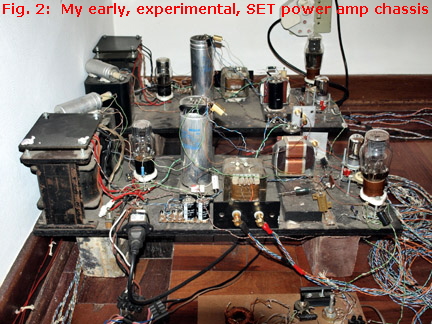 |
I developed a healthy fascination for wide-band drivers and all things OB at this time. A three year stint in the UK – during the time of my doctorial studies abroad, 2003-2006 – allowed me to link up with the hip triode loving community that side. I also took the advantage to audition as many wide-band drivers as I could, and just for kicks, here are some of my thoughts:
Lowther – the catchword is definitely ‘snap’, but it’s difficult for me to comment on these as everyone seems to put them in back loaded horns – more on that issue a bit later. Unfortunately, I have not heard the DX4 in Dick Olsher’s Diamond edition BassZilla, which uses notch filter to take out, or at least minimize the ‘zing and shout’, an approach that I thoroughly support.
AER – these German guys have done a serious make over on the main cone and whizzer, but otherwise their offerings remain fairly similar to Lowther. I believe I prefer the AERs to the Lowthers I have heard, as the AERs lack the more obvious negative artifacts of the Lowthers. AER drivers are arguable amongst the most resolved, extended and detailed wide-banders around. But, unfortunately, I find the ‘AER sound’ to be overly detailed, ethereal and far too ‘lit up’ for my taste. My friend James Doddington made a brilliant 2-way OB with these – the Quasar mk1 – with the sensational Supravox 12” wide-band woofer below 150Hz.
Fostex – I am familiar with FE103, FE166/167, as well as a few others I can’t remember just now, and more recently the FE208sigma. The 103 is exceptional in every way, as is the newer 108sigma, but at 3 to 4” you can’t expect much in the way of efficiency or bass. The 166 sounds good in the Cain and Cain Abbey, a tapered pipe, actually an underground DIY full-range classic, and this one together with the smoother sounding 167 present tremendous musicality for the price. And we shall get to the 208sigma a bit later on. I actually bought a pair of 167s based upon my various auditions of wide-banders in the UK (see Figure 3).
Phy – I heard the 8” Phy driver in the Solovox offering whilst visiting New York City. These are a nice option if you must go solo on OB, as the tonal balance is largely correct. But I wonder if the price is a little high for what you get, and being a mono-cone, these clearly lack the resolution of the better dual cones. For me, a tweet is mandatory.
Supravox – I am familiar with the 8” dual cone ferrite offering optimised for OB (93dB or so), the 12” ferrite woofer (which as already stated is an exceptionally fine piece), as well as the 8” mono-cone field coil. I heard the 8 inchers (ferrite and field coil) at Thorsten Loesch’s place in London, on OB, and have to say I like them both. Overall tonal balance is ‘natural’ and this sans filters. The field coils have exceptional mojo/boogie/dynamoHum–for the Zappa fans– and especially in the bass to mid registers, and these really do SLAM which appears to be the forte of this exotic driver. Although well extended, neither of these have the high frequency elegance and detail of the best dual cones drivers such as AER – in my humble and somewhat limited estimation that is. Still, nothing here a good tweet cannot solve.
I thought to slip in the Cyclops II here, a bi-pole tapered pipe, by PHI Hi-Fi Innovation – http://www.phi-audio.com/Cyclops%20II.htm – as it happens to be one of the best full-range designs I have ever heard. Well OK moderate efficiency and limited bass, but not as bad as you might think, and not everyone wants to bang head.
And to sum up, I hope it’s not overly audacious to say that I would not swap my current BassZilla for either of these, when played solo, that is!
I am not a loudspeaker designer, and I never wanted to get into this aspect of the chain, my primary interest being with triode amplifies and phono stages plus a bit of turn table DIY, but circumstance, it would seem, forced me to do so, and wide-band thinking has obvious appeal for a late starter like me. Returning from the UK, I had some good times with the Fostex FE167 on OB, with 12” woofer below, and I consider the FE167 to be a mighty fine driver for the price. Naturally Dick Olsher’s BassZilla was very much in mind, as I had bought his book, some years back, and poured over his fascinating designs. The most evolved BassZillas are 3-way designs, but conceptually Dick’s intention has always been to showcase the advantage of wide-band, highly efficient drivers. But there was a block, an obstacle that initially prevented me from building directly from Dick’s plans. His more recent offerings sport fairly big and complex filters, and like many of the other full-range fans out there, I was well into decrying filters. ‘Out, out … Get rid of your filters’ I was emailing to all my friends, at this time! In truth, I had had a bad experience with filters in the context of the Ariels and from this I jumped to the innocent yet incorrect conclusion that filters are ALWAYS bad. We have to be very careful with this word ‘always’ in audio, as the always is often proved wrong. Of the BassZilla designs on offer the one that I could comfortably afford was the Platinum edition, and this one has a ‘nasty’ 4th order filter at 4K, to blend a Fostex FE208sigma with a ribbon on top. Now ribbons are BEAUTIFUL, and a triode driving a highly efficient ribbon is a VERY SPECIAL THING!!! I have heard ribbons on numerous occasions, the most recent being in a friend’s system, Alan Hobkirk – who is like an audio ‘father’ to me – where an exotic custom made dipole ribbon plays down to 1K, or thereabouts, for truly magnificent sound. So I knew the Platinum edition with ribbon coming in at 4K was going to provide state of the art treble extension and naturalness on top. But this also requires a 4th order filter positioned at 4K in Dick’s design … arrrrghhhhhh. I used to look at the filter plans daily, and ask myself ‘should I … or … shouldn’t I’ … it was driving me mad!
Next up, a bit of luck from out of the blue. I landed a pair of Goodmans Axiom 80 full-range drivers (see Figure 4) – designed by Ted Jordan – that are reputed by some to be the best darn full-range drivers ever made (I also have a pair of Goodmans Axiette drivers, from the same era). And certainly from my own experience of these exotic babies – 16 ohm, 98dB or so, 9” dual cone, alnico, with a surround-less design that works by virtue of adjustable springs – that description may well be right. I eventually landed up with the AX80 playing above 600Hz on OB powered by SET – cos the lower mids are sucked out – with the Goodmans Audiom 61 woofer below, again on OB, and powered thanks to bass lift from a Nelson Pass style F2 current drive amplifier, and an Eminence AMT horn – phenolic diaphragm – as super tweet on top (see Figure 5-6, schematic shows later attempt to lower Xover down to 250hz to make the AX80 top compatible with a ‘potential’ BassZilla). This was a very beautiful sounding set up, barring two not insignificant points. One, the dipole woofer did not play low enough to sound good over a wide range of musical program. Two, the Axiom has a coated whizzer cone. One of my whizzers is without that shiny coat – sadly it appears to have peeled off – and stereo was not correctly balanced on some recordings. Imbalance in stereo is like looking at a painting that is hung skew. These things irritate, and eventually it got to the point where I began to tire of my lovely Goodmans OB’s.
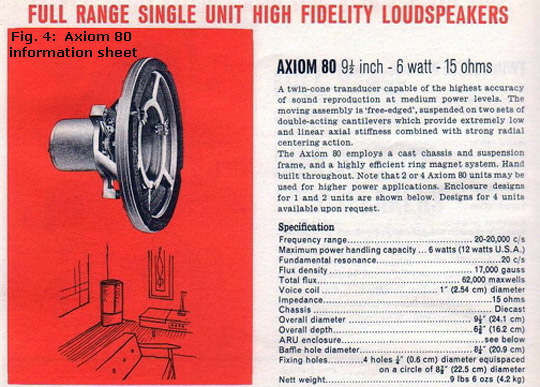 |
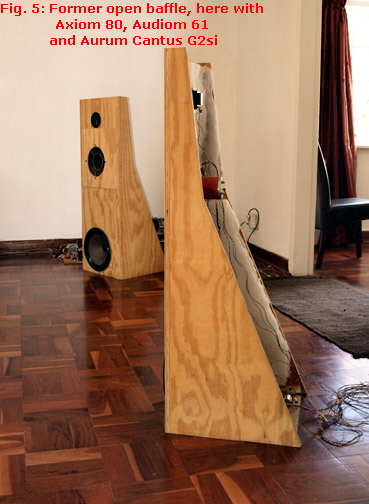 |
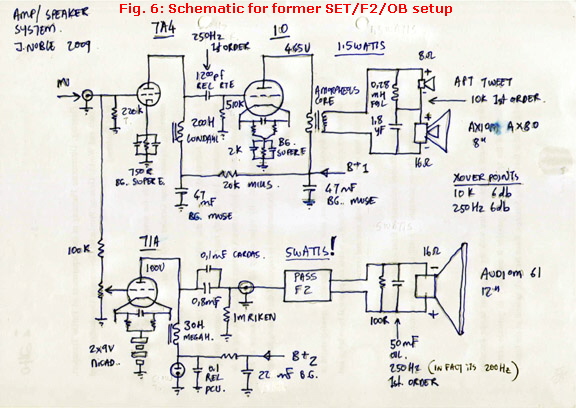 |
Should I … or … Shouldn’t I … Well, I did, because the BassZilla ‘system’ clearly allows me to use my AX80, the 167 or any other wide-band driver I may wish to obtain, on an OB top, but fortunately I chose to build the full hog, exactly as designed, and am thoroughly glad I did. I am truly delighted with the Platinum mk2 BassZilla, which has surpassed my wildest expectations, and is easily one of the finest loudspeakers I have heard full stop, plus it happens to be the one that I now own. The AX80s collect dust! There’s a sure sense of naturalness, of rightness to the sound of BassZilla. Dynamic resolution is exactly as you would expect from a 97dB design, and bass extension is such that the ‘snap’ in the mids is married to an equally impressive ‘slam’ in the bass. The mids have lots of magic, very much Estat in character, with openness, depth, ambiance and naturalness, whilst highs are well extended, detailed but also sweet and refined. You want ‘hall effect’ you’ve got it! On some classical recordings the orchestra is positioned 20 meters or more behind the loudspeakers with ambiance and a wonderful sense of air in between. On my former mono-poles this type of recording would often sound distant, muffled and flat, lacking in life and sparkle. Not so with BassZilla. Please take a look at this photograph of Laika, my ever so sweet, then six months old, female, Irish setter pup, which is included here by way of analogy (see Figure 7).
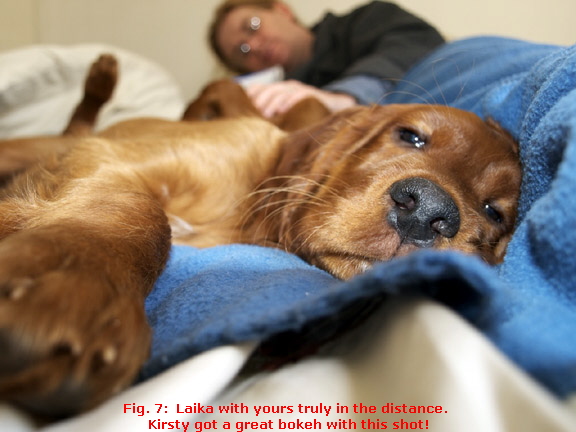 |
The zoomed in focus and detail on her face and nose is dramatized by virtue of the blurred, out of focus background, where yours truly lounges in his Sunday best reading the morning paper. The sense of depth introduced through the blurring of distance heightens the perceived sense of presence and detail in the foreground. Photographers refer to this technique as bokeh. Well I’m here to say that if the source is up to it, BassZilla will render the audio equivalent of this dramatic effect, with reach out and touch it 3-D palpability, with space in between and around things, and atmosphere that fades with distance into deep ambient space. Stirring stuff indeed.
BassZilla also does the chameleon thing incredibly well, morphing from soft to loud, from silky to bite, from woodiness to air and back again. I am a big fan of what some alnico based drivers do best, namely tonal richness, and the Axiom 80 has that character in spades. Yet oddly enough, I do not miss the AX80, now that BassZilla has taken up residence in my lounge. Well OK, the AX80 did have a special kind of mid band magic – alnico? – which would manifest from time to time on certain recordings, a solo voice here, a cello there, a magic that the Platinum mk2 does not always match. But, yes BUT, it’s not a clear case, as I find the BassZilla has a magic of its own. Tone is rich and fulsome. With BassZilla I get all those throaty sounds on vocals, and the wooded body of the cello. BassZilla loves to excite real word resonances, such that I can reach out and touch the body of the instrument that apparently is there, I mean here in front of me. And I don’t miss the AX80. BassZilla is really that good. As a matter of fact, it’s the other way round. As noted the AX80 has a special magic on certain recordings, yet in addition can sound off at times. BassZilla, by contrast, is much more consistent and chameleon like, and generally sounds good no matter what I throw at it. To illustrate the point, just the other night I played a Miles Davis track – can’t remember which one – and it occurred to me that the AX80 used to have a bit more presence on the opening bars of Miles’ horn, and I remembered how I would tend to lift the stylus soon after, as the tracks that followed were somewhat off – perhaps the engineer when to the john or something. Anyways, with BassZilla, I was sitting there saying that horn lacks a wee bit of presence, but thereafter was sucked in, and before long the stylus hit the lead out at the end of side. Goodness me, it seems I had listened to the full LP, without any second thought, as if in a trace! With BassZilla I listen to music, I listen to full LP’s from beginning to end, which is truly liberating. I can’t think of better praise to Dick Olsher’s achievement than this.
Returning to questions of design. You look at Dick Olsher’s crossover plan for the Platinum mk2, and you say to your self, what the hell is this guy doing!!! All those caps and coils. But when you listen to the result, it all makes beautiful sense, and I will take this reality over popular belief any day. Let’s be honest. In most cases we full-range fans love our diatribe because properly conceived Xover filters and multi-way designs are difficult to resolve. BassZilla has a perfectly seamless sound. It sounds apiece all the way up and all the way down. I don’t hear woof, or mid or tweet, just an incredibly coherent sound. Surprisingly I don’t hear any change in character between the boxed bass and the dipole mid. This was one aspect that worried me at first, as my own Goodmans based attempt had OB bass. I came to the BassZilla from a dipole bass, and yet, for whatever reason, the BassZilla bass cab does not disappoint. Bass has exceptional fidelity and in no way sounds ‘boxed’ or even constrained. A sceptical friend, who is generally unkind to generic bass reflex designs was heard to say, ‘but Jon, it’s not bass reflex, it’s a ported sealed box’!!! he .. he .. he !!! In any event, upon hearing BassZilla one immediately understands that this speaker was designed by a man who truly admires and loves ‘full-range’ drivers, and wide-band designs. BassZilla has a full-range character, one that is completely beguiling and consistently well timed due to the integrated nature of the sound. The seamless integration of the ribbon is no small feat, as Dick has clearly succeeded where many have failed. Boxed 2-ways with ribbons commonly change character where the ribbons kick in. Not so with BassZilla, and I suspect the good transient capabilities of efficient paper cones may be partly responsible for his success.
It is perhaps helpful to know that BassZilla was, originally, a Lowther DX4 based design. Indeed, the entertaining name, BassZilla, is no doubt, intended as a not so subtle jibe against the typical bass less sound of many a Lowther back loaded horn. Back loaded horns don’t do bass, well not the ones I’ve heard at any rate, hence the cool aspect of Dick’s naughty joke. This dear Lowther fans is the BASSZILLA – bass cos it has some, and Zilla, cos yea you guessed it, it’s kinda big! The early designs were much more ‘pure’, ‘ideologically correct’ if you will, with just the OB Lowther playing above 150Hz and the big woofer cabinet below, and crossed with a minimal 1st order filter. As the design developed, however, Dick discovered that steeper filters were required to protect the delicate DX4, which can only muster a tiny Xmax of 1.5mm. The woofer went through a few incarnations, mostly due to discontinued driver units, and eventually a ribbon super tweet was added on top. Now, I am not anti-whizzer cone. In my book, whizzers are cool, and do many things that conventional dome tweets – soft or otherwise – simply cannot and do not do. Whizzers seem to have exceptional transient capabilities; these things project, and communicate.
Nuff said. But there are know negative artefacts from most of the whizzers out there. And you have got to be one cold hearted, narrow minded, ideologically pure, whizzer worshiping Neo-Nazi not to notice the refined, elegant and sweetly extended top end of a good ribbon – either as tweet, or super tweet. And when you hear what a ribbon does as a super tweet – and believe me I did, I bought the ribbons first to try out with my former AX80 based OB – then you say to yourself, I wonder how grand it would be if that there ribbon played down a little lower. The thought is irresistible. And before long, the temptation is such that full-range morphs into conventional multi-way. The Platinum mk2 BassZilla design selects Xover points at 250Hz, and 4K – boring, you might wish to say. This one is the most narrow-band of the ideologically wide-band BassZilla designs, and as such it resembles a classical 3-way. It also happens to be Dick Olsher’s personal favourite at this point in time, unless of course, he has moved on since we last spoke – never blame an audiophile for having moved on! The rationale for the Platinum mk2, however, would appear to be more prosaic, as the former dual cone version of the FE208 was pulled and replaced by the sigma version, which is a mono-cone, and not as wide-a-band as before. Dick had to re-think the design to accommodate the new FE208sigma, and what an incredible driver this is, when used the way Dick does. Tone, life, transparency, the BassZilla implementation of the FE208sigma seems to have it all. And I wish to quickly note that the other Fostex drivers I have heard, when played full range, or almost full range, have tended to have a slightly thin and lean tone. Not so with the Platinum mk2 which is a true Tone Meister, with richness and naturalness aplomb.
Great. So I am going to build a BassZilla!!! By the time the drivers arrived I was fever pitch (see Figure 8).
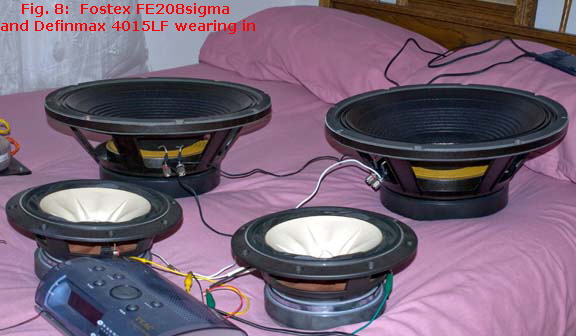 |
The FE208sigma was a pleasant surprise. This thing is beautifully made, and way too cheap for the amazing quality on offer. It’s heavy too, with a massive magnet assembly, and exceptionally solid frame. The unusual folded cone and rubber surround are equally impressive, indeed as is the sound. As for the woofer, HOLEY MOLEY, what a joy to behold this beauty, to carry this creature of the night in my hands. When it comes to driver selection for this project, Dick Olsher shows tremendous class. In the meantime, I had lined up a talented cabinetmaker to make the elaborate bass cabs. I really love what architect Kevin Kerwin has done with the mk2 bass cabinet, and I decided to follow his published drawing, only I had to convert the dimensions to metric, and elected to use circular holes cut into the inner bracing members, as this is easier when building by hand. This intention required me to re-calculate the specified internal volume, and consequently, my cab is slightly less deep than Kevin’s design. And I wish to add that Kevin has done a great job on the aesthetic aspect, as these bass cabinets are nicely proportioned, and look truly great, in my opinion (see Figure 9-12).
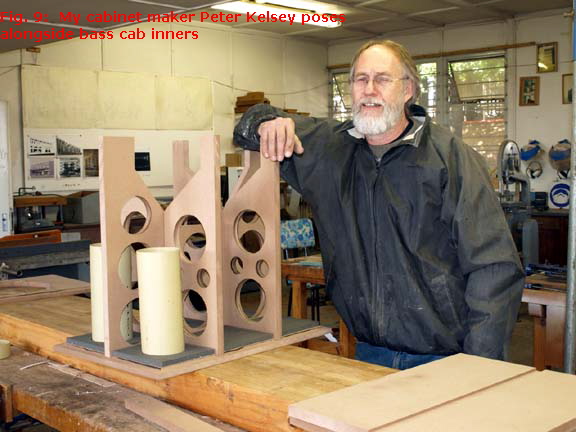 |
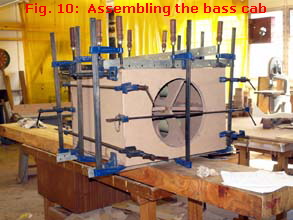 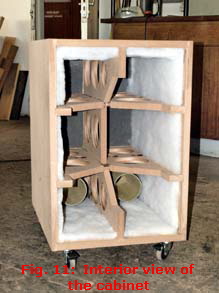
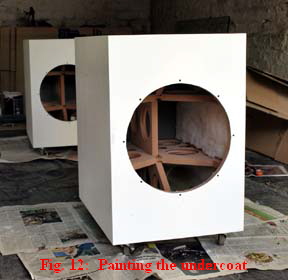
My wife was less keen, however, and for which reason I was looking to introduce something special and beautiful into the execution of this project, to make my Zilla more home friendly, to secure a bit of WAF appeal. As much as I like Kevin’s bass cabinet design, I find his execution of the OB’s to be a little heavy handed and somewhat overly ‘framed’ for my taste. My intention was to create a lighter and more elegant look to the OB, one that would seem to ‘float’ atop the bass cabinet which provides support. From this, I decided to opt for MDF – Supawood – for the bass cabinet, because MDF is in-expensive, dense, quite OK in the context of a bass cab, and workable because it must be said that Kevin’s cabinet design is not exactly easy to build. My idea was to paint the bass cabs black, because MDF paints up nicely, and black helps big things to disappear, well sort off. For the OB tops, however, I decided to opt for a thick slab of hardwood, and to have the edges carved into a shallow curve, to lend a touch of elegance, but also to aid the dispersion of sound, as the curves reduce diffraction effects at the edge of the baffle. After considering a wide variety of hardwoods, I eventually opted for Imbuia, an exotic and expensive hardwood, selected because of its dark almost ebony like hue – chosen to work with the black bass cab below, as well as its density and beautiful grain. Imbuia is used for guitars, and is noted for its clear and clean delineation of tonal differences. At this point I offered a pair of Imbuia OB’s to Dick Olsher, as to make four is not so different that to make two. Dick Olsher after all is the Black Dahlia audio man, who in my view, was deserving of a BassBlackDahliaImbuiaZilla. Dick said great, and thanks! And fortunately, the BlackDahliaOB made the Atlantic crossing, from Africa to America, without damage, and Dick tells he is delighted with them. I thought it a small a gesture, and a polite way of saying thanks.
My carpenter, Peter Kelsey, is a perfectionist, and did a truly superb job (see Figure 9). Thanks Peter! I wish to add that a trial OB was first made from South African Pine, to get the working process right (see Figure 13), and to allow me to hear my Zilla prior to springing for the costly Imbuia option. SA Pine is fairly soft and light, whereas Imbuia is very heavy and dense, and in truth I was not prepared for the big difference to tonal balance that occurred when moving from Pine to Imbuia. I can’t really say that the difference is an improvement as such, but clearly Imbuia has a much brighter tone, with a cleaner delineation, and superior micro dynamics, the latter being the primary plus point. As a matter of fact I had to re-balance the system for use with the Imbuia baffle – a cap here, a resister there – as initially the Imbuia OB sounded a little bright.
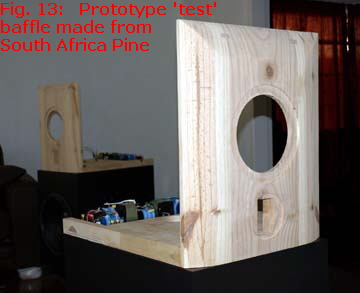 |
The final result looks really fine (see Figure 14-17). My wife Kirsty – who had previously stated, ‘Jon why do we have to have these ugly things in our lounge, why can’t we return to the slim, beautiful Ariels’ and to which I replied ‘yea honey, the Ariels may have looked great, but they didn’t sound as nice as they look’ – was not terribly impressed and my appeals seemed to fall upon deaf ears. Yet now that the finished ImbuiaBlackZillaOBs have taken up residence in our new lounge (see Figure 18), Kirsty was heard to say, ‘you know what, they don’t look half bad’, and ‘the Imbuia is really beautiful dear, you must be proud’. Phew, its by the skin of one’s teeth, I tell ya!!!
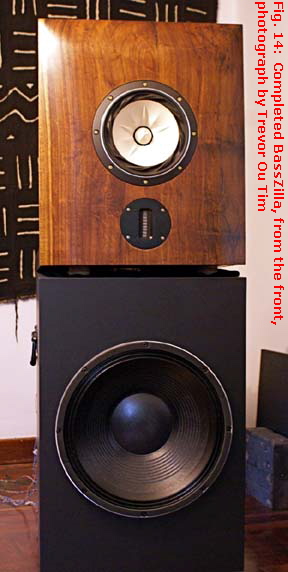 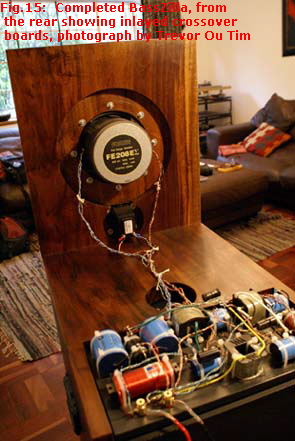
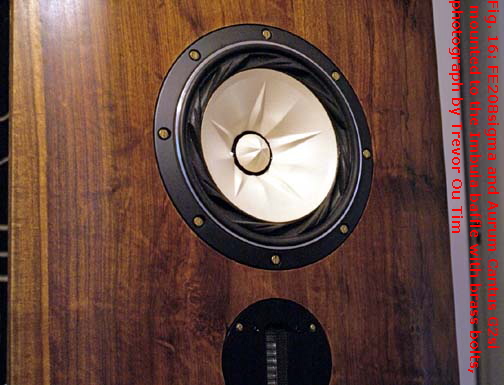 |
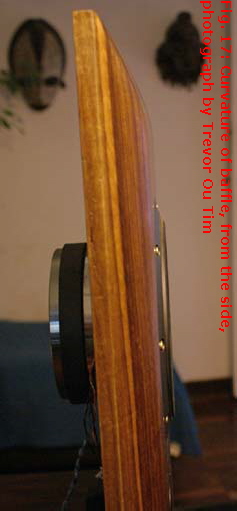 |
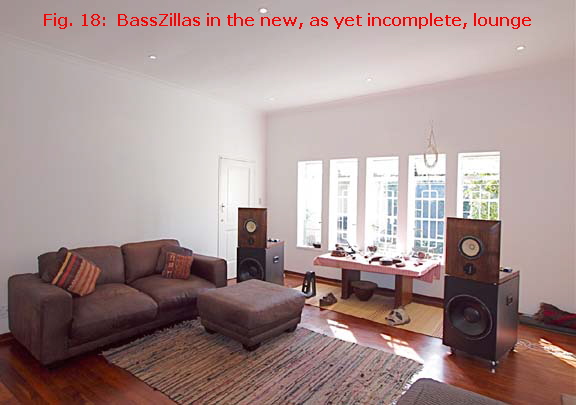 |
A further innovation in terms of my implementation is to bi-amp the Zilla, with transistor power on the bass and SET above. Currently I listen via a glorious SE10 (see Figure 19) – you have got to hear the 10 to believe it, OK – which is my absolute best amp so far. The 1.5 watts on offer here is almost as low as you can go in the crazy world of SET, and the BassZilla, amazingly, when bi-amped, is quite OK in this exotic triode context – 97dB is enough! Below I currently use a Nelson Pass style F5 (see Figure 20), which has proved to be a truly brilliant bass amp. Indeed I like the F5 so much, I shall state that you can built this baby and play the Platinum mk2 full range, and not lose on anything. The F5 is honorary SE DHT, in my book, and ol’ Pass is pure genius to have achieved this from ‘suspect’ SS devices. If you should happen to be listening in, WE LOVE YOU NELSON!!!
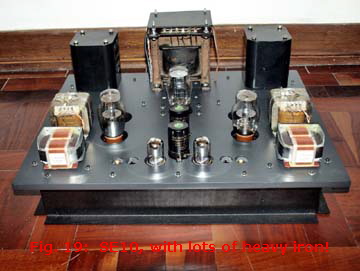 |
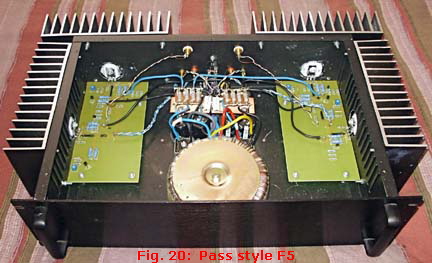 |
My Flamingo phono has an integrated line stage, which drives the SE10 which drivers the OB top. The line out from my phono also drives a second line stage, this being Dick Olsher’s wonderful Blue Velvet (see Figure 21-22), to allow me to set relative volume in the bass channel – and to lower impedance out so I can drive any bass amp I choose – and which in turn drives the F5 that powers the bass cabs (see Figure 23). If you want to try bi-amping, I can firmly recommend an approach of this kind. Trust me, I tried a fair number of unsuccessful paths. Prior to the Blue Velvet, a lovely sounding 71a line stage used to power the bass line. But despite glorious sound from the 71a line, I never did solve the hum – despite strenuous efforts – and when this line blew up on me, and damaged my then GainClone bass amp, I decided to move onto Dick’s Blue Velvet, and can say I am thoroughly satisfied with it. The Blue Velvet performs brilliantly in this application, and I have no intention to change it.
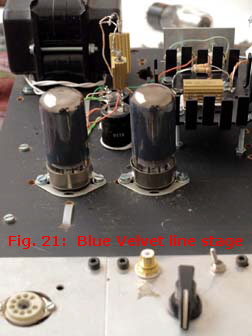 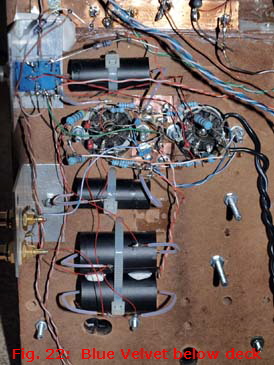
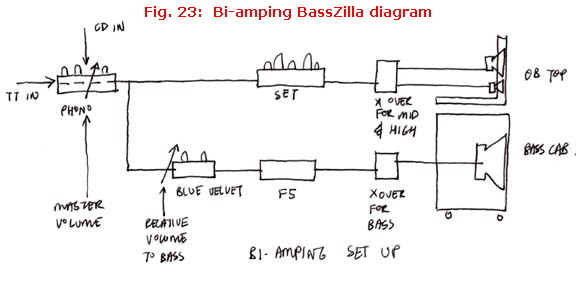 |
I have thought to add a few notes regarding my finding with respect to bass amps, should someone out there want to try bi-amping their Zilla. Well the F5 is the undisputed King, so far, and I doubt I will want to move on from this piece of lovely. Some say you must not/cannot mix solid state with tube, and that a tube amp on top warrants a tube below. I say poppycock, because I have been doing the ‘deviant’ SS thing on the bass for years, and with terrific results – and alienated some purist triode friends along the way, oh dear! Fair enough, you cannot merely hook up any old solid state amp below and expect good results – a lot of SS amps frankly sound bad. For sure, you hear the tone of the bass amp in the bass, and this has to blend with what’s on top, else serious discombobularity will result. But ditto is also true for an all tube rig. It should be noted that the Platinum mk2 is an excellent candidate for bi-amping due to the simple 1st order filter on the bass – 2nd on the OB top – which allows for a wide overlap between woof and mid driver, aiding integration.
With my Ariels I once tried a PP300B on the bass and SE2A3 on the tops, which simply did not work because I was hearing 300B below and 2A3 above. So the tube with tube, and zero feedback with zero feedback formulae is not always the answer it is theorised to be. Through time, I discovered that the humble GainClone – my version of which uses Black Gate NX type PSU caps, and Riken Ohm resisters, try it!!! – blends very nicely with low power SET such as 2A3, 45 or even the superlative 10. Hot tip, clean DHT – i.e. 2A3 – is a must for blending with handsome solid state below. And of course the driving line stage needs to be sympathetic, one that can add in some of the triode romance that SS commonly lacks. So my obvious first attempt on the Zilla’s bass was my trusty GainClone, driven by the aforementioned 71a line, then later the Blue Velvet, and I can report the GC does a fine job. Clearly this is the best cost effective choice, and indeed the ‘one to beat’. A very nice looking Japanese, 25 watt, class A solid state amp, brought in by a friend, did not work so well, sounding somewhat constrained and overly dry. I thought the Trends switching amp – T-amp – I tried sounded very nice, with lots of get up and go, more so than my GainClone but not that different into the balance. A nameless, yet well regarded tube amp proved useless, hey but my mind was poisoned from the start. Look, I am actually on a mission to try each and every bass amp I can lay my hands on, so if you’re in the Johannesburg region, do drop me a line! But the striving has been seriously softened, if not eliminated altogether, as the F5 sounds wonderful, a true winner from the start. The F5 has brought a new sense of refinement, clarity and especially purity to the low registers that blend perfectly with the elegant sounding 10 on top, plus the F5 has added almost an octave below what the GainClone can muster. Tremendous stuff indeed.
Do the math – a 25 watt, class A, solid state amp, when given the privilege to drive an easy 97dB load, is easily equivalent to a 250 watter in the context of your average current sucking audiophile loudspeaker. Play 3dB lower than the house next door, and you’re now in 500 watt headroom territory. Where are you going to find a pure class A 500 watt amp? Simply put, this is the true advantage of a sporty 15” woofer! Err, that and the tone, cos a 15 definitive does bass tone – as any self respecting electric bass player will happily tell.
Finally as outro, I wish to mention a few small set up notes and tweaks that may be of interest to prospective users. Dick Olsher recently moved from the original G2si onto the better and more expensive G2 tweeter. The G2 apparently has a little more output and therefore works best. I intend to make the upgrade, but a good remedy for the interim, I discovered, is to rotate the top baffle up a little, which has the perceived effect of increasing treble output. I have small rubber feet placed under the front edge of my OBs, which do a good job of lifting the highs, and without negative artefacts from what I can tell. In point of fact, the treble balance is easily tuned by incurring small rotations of the top baffle. Lastly, regarding the crossover, I used the precise parts as recommended by Dick in his mk 2 update article, namely: Clarity Cap SA types for the tweeter, PE types for the mid driver and bypassed with Mundorf Supremes, PE types for the bass, Madisound Sledgehammer iron cores for the really big chokes, and air core chokes of the specified size everywhere else. Mundorf non-inductive power resisters were selected by me. Look, I am a self-professed cap fetishist yet have no intention to ‘upgrade’ these filters as the end result is truly superb. I have been a long time fan – 10 years or more – of Clarity Cap SA types whose only negative artefact seems to be a touch of warmth, but this cleans up very nicely with careful bypassing. Read here for Tony Gee’s excellent discussions on crossover caps, to which I fully concur – http://www.humblehomemadehifi.com/Cap.html
Knowing that the SA types are best bypassed, I was sure to make a series of patient experiments with various contenders I had lying around. Most worked well, but I have settled for Mundorf 0.1uF silver in oil caps to all four – that’s for the stereo pair – of the tweeter, series path caps, as these appear to work best. The small silver oils really do the trick, adding that last bit of polish, spaciousness, detail, air, ambiance, gentleness and refinement to proceedings. Exactly what the doctor ordered.
|